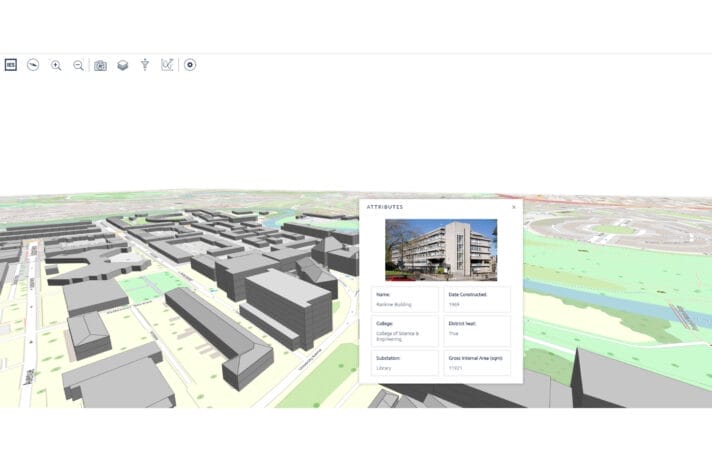
The eDigiT2Life project innovates both in the technical methodology, to evolve the digital twin; and in the business model utilised to commercialise its adoption and proliferation.
The ‘eDigiT2Life’ project is an Innovate UK funded research and development project where HLM Architects, IES, University of Glasgow and Sciencescope collaborated to develop and trial a campus Digital Twin, evolving from compliance building models to operational/live digital twins in order to optimise whole-life performance of buildings.
HLM partnered with the University of Glasgow, IES and ScienceScope to develop a Digital Twin of the campus, including the James McCune Smith Learning Hub building, with the aim of optimising whole-life building performance to drive a Smart Campus approach. The process anticipates enhanced sensing and metering infrastructure enabling streamlined and automated calibration of compliance models.
Key Achievements
The project developed and applied digital twin technology to real projects, identifying the blockers to adoption, and proving anticipated benefits.
Technically, the project:
- Developed fortified design stage dynamic simulation models of buildings that anticipate enhanced sensing and metering infrastructure;
- Developed a methodology to calibrate design stage compliance models of buildings to be used during handover, commissioning and initial operation phase (post occupancy evaluation);
- Developed the operational twin of buildings as an evolution of existing calibrated dynamic simulation models;
- Developed user-centred immersive dashboards of the operational digital twin;
- Developed functionalities of the digital twin that include energy, comfort and flexibility optimization, predictive maintenance and M&V;
- Determined the business model for a compliance/commissioning/operation Energy Services or Facilities Management company that will be responsible for all stages of modelling based on a modified EPC approach;
- Trialed the methodology and assessed the business model’s effectiveness in two newly constructed buildings under different phases of construction and engaged with end-users and the construction-oriented business and academic community;
- Explored the application of the technology to existing buildings within the estate proving it was equally useful to the optimisation of these buildings particularly when scenario testing for retrofit.
The project highlighted blockers around data connectivity, ownership and coordination at procurement stage, enabling the University to develop procurement strategies and briefing for Building Management Systems (BMS), how data is stored, and the ownership and access to that data, to ensure future digital twins can be easily connected to the BMS.
As well as having the systems in place to collect and store that data the project highlighted the importance of people skilled in data analysis to interpret that data, this may be a new role for estates departments to consider in the future as the technology is rolled out.
The project delivered benefits to the handover and operational phase of the new builds, including evidence-based identification of MEP system commissioning deficiencies as well as ongoing use of occupancy data to inform the day-to-day operation of the building and opportunities to reduce energy use.
The success of the project is measured in how the University of Glasgow are able to respond to the data provided by technology on the pilot buildings to make better informed decisions on both the management of their estate and future investment in buildings and systems to achieve their net zero goals. The university are able to optimise building performance today as they develop their detailed net zero roadmap for the future.
The interest in the project from other university estates departments and AUDE members confirms that we have collectively developed a way to help building owners understand the performance of their estate – and the steps needed to meet their sustainability goals.
This short film details the project and the team’s ambitions: How digital twinning can help us build more climate friendly buildings – YouTube





